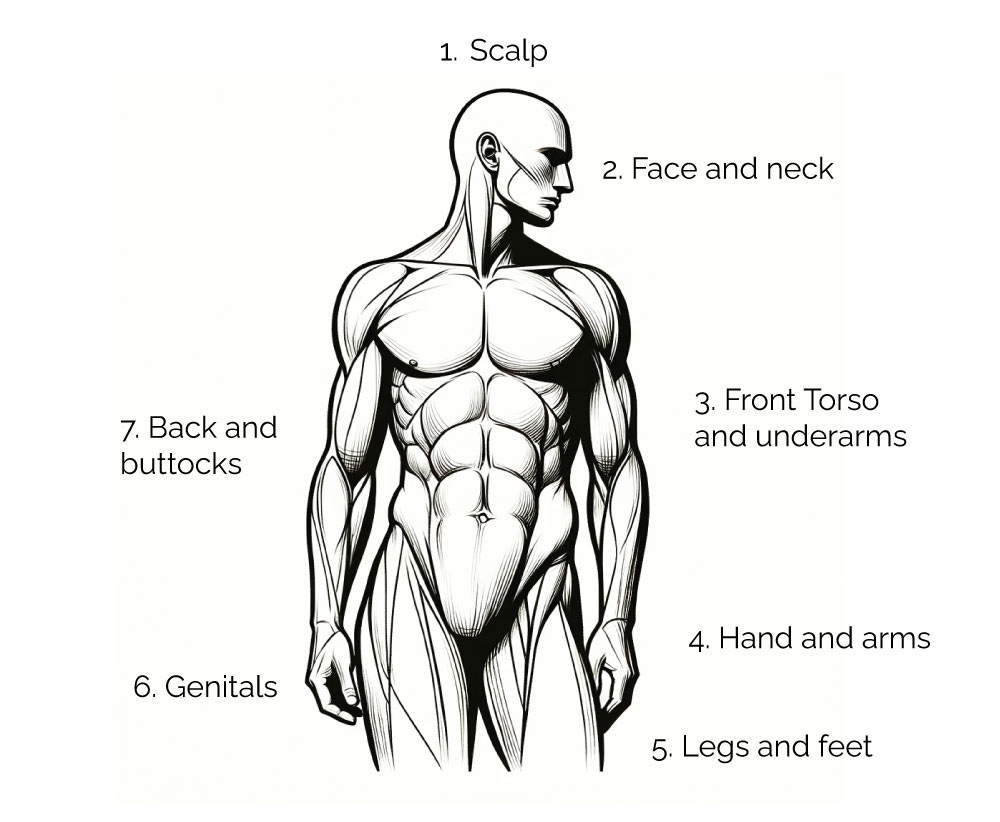 | 12 min read
| 12 min read

When detected early skin cancers can usually be cured with relatively minor skin surgery. For example, melanoma - the most serious form of skin cancer - has a 5-year survival rate of more than 98% when detected as the earliest stage (Stage IA) however this drops substantially when melanoma has spread elsewhere in the body. This emphasizes the importance of detecting skin cancers as early as possible. In this article, I have outlined my approach to checking your skin for skin cancer. I have summarised what you need to look for, a step by step approach to examination and how to monitor for changes over time with photographs.

When you are checking your skin it is important to know what you are looking for! The three most common types of skin cancer are basal cell carcinoma (BCC), squamous cell carcinoma (SCC) and melanoma. These have characteristic appearances.
Basal Cell Carcinoma: This appears as a shiny or pearly lesion. Sometimes, you might also see tiny blood vessels. BCCs can also appear as non-healing wounds.
Squamous Cell Carcinoma: These are typically red, scaly patches or fast-growing lumps. They might feel rough to the touch and have crust or scale over the top. They can often bleed if bumped or injured.
Melanoma: This can manifest as a dark mark on the skin, a new mole or a changing existing mole.
Other things to look out for on the skin include the following:-
For moles (dark skin lesions) there are certain features to look out for which can be a sign of skin cancer. These are known as the ABCDE rules:-
Lighting: Natural daylight is best as it provides a bright, even illumination that makes it easier to spot irregularities. However, if natural daylight is not available, a well-lit room with bright artificial lighting is fine. Ensure that the light source is strong and evenly distributed to avoid shadows or glare.
Mirrors: A handheld mirror is particularly useful for inspecting areas like the back of the neck, scalp, or other areas that are difficult to view directly. In combination, a full-length mirror is beneficial as it provides a comprehensive view of the entire body. Positioning yourself between the two mirrors can allow for a full 360-degree view enabling you to check places that would otherwise be difficult to see.
Camera, phone or tablet: A smartphone or tablet with a camera is a valuable tool for tracking and documenting changes in your skin over time. These photos serve as a valuable reference point, allowing you to notice any new developments or changes in existing moles or lesions during subsequent self-examinations.
Assistant: If possible it is helpful if you can ask someone to help you - this particularly useful for taking photographs of the back and areas that are more difficult to access.

Scalp: Using both hands, begin at the front of your hairline and move towards the back, parting your hair to inspect the scalp. Use the handheld mirror to get a closer look if needed.
Face & Neck: Use the full-length mirror to check your face and neck. Pay attention to the eyelids, nose, lips, mouth, and ears. For the ears, use the handheld mirror to view areas not visible directly.
Front Torso & Underarms: Look at the front of your torso. Women should lift their breasts to check the skin underneath. Make sure you check the underarm area.
Hands & Arms: Start with your palms and the back of your hands. Check every finger's front and back, including the nails. Progress upwards examining both sides of your wrists and forearms. With the help of the full-length mirror, inspect the upper arms.
Legs & Feet: Begin at the thighs and move down to your shins, calves, and ankles. Sit down and place each foot on the opposite knee to inspect the soles, spaces between the toes, and nails.
Genitals: Sit down and use the handheld mirror to inspect the genital area, ensuring you view all areas.
Back & Buttocks: Stand with your back to the full-length mirror. Use the handheld mirror to inspect the back of your neck, progressing downwards to your upper back, lower back, and buttocks. Make sure you check both sides of each buttock.
Commonly Overlooked Areas:
Fingernails: Melanoma can develop under the nail. They will generally appear as dark streaks and these should be checked by a doctor particularly if changing over time.
Palms and Soles: Melanoma can also develop on the palms and soles. This is more common in those with darker skin types.
Genitals and Buttocks: Use a mirror to check these areas.
Breasts: Women should lift their breasts to check the skin underneath.
In most cases a skin cancer will change visibly in appearance over a 3 month period and regularly taking photographs of your skin is one of the most important things that you can do to detect skin cancer early. Photographs allow you to detect subtle changes that might not be immediately noticeable to the naked eye or to spot new skin lesions that you would not otherwise have seen.
Aim to take photos in the same lighting conditions each time and keep to the same body positions and angles. This allows side-by-side comparisons. Many modern phones and tablets have high resolution cameras that can produce good quality images of the skin. Tablets are particularly useful when comparing photographs with lesions on the skin.
It's important to photograph not only larger areas of the skin to spot new skin lesions but also to take close-up shots of specific skin lesions to check for any subtle change in the appearance over time. Organize your skin photographs according to date and body site or use a specialized app that can help with this.
Regularly checking your skin with the aid of photos is the most important thing that you can do to pick up skin cancer early. If you are worried about a skin lesion then it is helpful to see a dermatologist who can assess further. Additionally, when you have a lot of skin lesions it can be difficult to know which you need to worry about and it can be helpful to see a dermatologist to be sure that all are harmless and then subsequently monitor them over time to ensure that they are not changing.
A mole check consultation with Dr Lynch costs £250.
To book an in person consultation, enter your details below and my practice management team will contact you to schedule the appointment. Alternatively call 0203 389 6076 (calls are answered during working hours) or email: contact@drmagnuslynch.com.